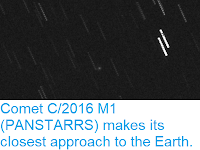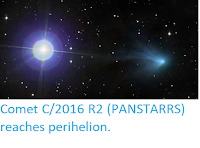Comet 38P/Stephan-Oterma will make its closest approach to the Earth for several decades on Monday 17 December 2018, reaching a distance of 0.77 AU from the Earth (77%
of the distance between the Earth and the Sun, or 114 550 000 km). At
this distance the comet will be not naked eye visible, having a magnitude of slightly over 10, requiring a reasonably good telescope to see it, in the Lynx Constellation, which is better observed from the Northern Hemisphere.
Comet 38P/Stephan-Oterma imaged on 18 September 2018 from the Novosibirsk Oblast of Russia. Mikhail Maslov/Fachgruppe Kometen.
38P/Stephan-Oterma was first observed on 2 January 1867 by Jèrome Coggia of the Marseilles Observatory, but he did not recognise the nature of his observation, allowing Édouard Stephan, the director of the Marseilles Observatory, to claim discovery of the new comet when he observed that it had moved a few days later. The comet not observed again until November 1942, when it was observed by the Finnish astronomer Liisi Oterma. The name 38P/Stephan-Oterma implies that it is a periodic comet
(P/) (all comets are, strictly speaking, periodic since they all orbit
the Sun, but those with periods longer than 200 years are considered to
be non-periodic), that it was the 38th comet (comet 38) discovered and that it was
discovered by the Stephen and Oterma.
38P/Stephan-Oterma has an orbital period of 37.8 years and a
highly eccentric
orbit tilted at an angle of 18.4° to the plain of the Solar System, that
brings it from 1.58 AU from the Sun at perihelion (158% of the distance
between the Earth and the Sun, slightly outside the orbit of the planet Mars);
to 21.0 AU from the Sun at aphelion (21 times as far from the Sun as
the Earth outside the orbit of the planet Uranus). As a Comet with a Period of less than 200 years and
more than 20 years it is also regarded as a Halley-type Comet.
See also...
Follow Sciency Thoughts on Facebook.








